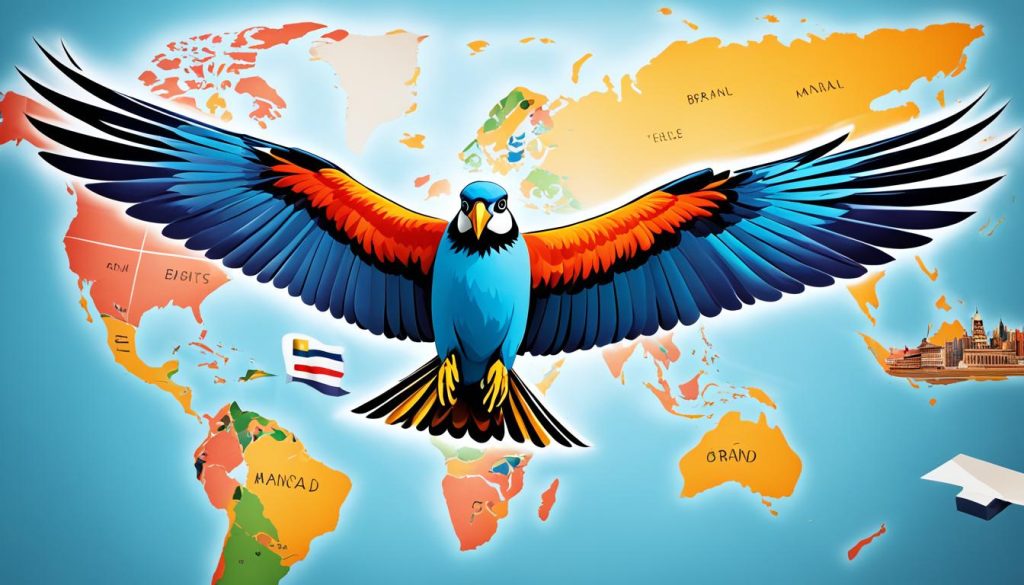Expanding internationally helps businesses grow and find new customers. It opens doors to reach more people and achieve success over the long term. But, entering a new market overseas successfully requires a lot of planning and smart choices.
When you decide to go abroad, there are many things to think about. You need to look at the competition, figure out what people there want, and know the laws and customs. It’s also crucial to understand the culture and consider how to get your products or services to customers in that country. All these steps help in picking the right place to launch your brand, plan marketing, and make a smooth start.
Getting your brand known in other parts of the world can bring big chances. You can grow your business, win more of the market, and be recognised globally. Next, we’ll talk about different strategies to enter a new market. This will give you ideas on how to introduce your brand to foreign customers in the best way.
Choosing the Right Market Entry Strategy
When thinking about expanding your brand overseas, picking the right way in is key. There are many strategies to think about, each with its upsides and downsides. Your choice will be based on your business’s specifics, who you’re targeting, and what you have to work with. Let’s look at a few common methods:
- Exporting: Sending your goods or services to another country through local agents or distributors.
- Direct-to-Consumer (D2C) Model: Selling products online and delivering them straight to customers in the foreign market.
- Franchising: Letting others in different countries use your branding and sell for you.
- Licensing Agreements: Giving companies in other places the right to use your name or production methods legally.
- Partnering and Joint Ventures: Working with businesses from the target country, bringing their know-how and helping with cultural hurdles.
- Piggybacking: Joining forces with businesses that offer different things to sell your products in the new market.
- Foreign Direct Investment (FDI): Investing in companies from the foreign country or starting your own operation overseas.
- Wholly-Owned Subsidiaries: Owning everything in a foreign branch, giving you full say over operations.
Picking the right way in involves deep thought into what your business truly needs. It’s really vital to weigh the pros and cons of each method. Make sure they fit with what you have to offer and the conditions in the new market. By choosing wisely, your chances of making a mark overseas go way up.
Exporting as a Market Entry Strategy
Exporting is a well-liked and low-risk tactic to reach global customers. It lets you offer your goods in foreign lands without big investments there. With this method, you make your items in your own country and then use agents or distributors in the target area.
This approach lets you use your current products in new markets. You can grow your reach and find new sales chances worldwide. It’s great for companies with a strong brand who wish to sell globally.
But, you must think about a few key points with exporting. Getting your items to the new market costs money. Making sure your goods get there on time is key to keeping customers happy.
Customs fees and taxes in the new country can cut into your profits. Always check the rules of the place you’re exporting to. This way, you won’t be surprised by extra costs.
Also, you might not be totally in control of how your goods are sold. Local agents or distributors will handle sales. So, keeping in touch and working well with your overseas partners is crucial.
Still, exporting is a good choice for expanding globally. It helps you grow your sales without big initial costs. Plus, you can serve more customers and risk less in new markets.
Direct-to-Consumer (D2C) Model for International Expansion
The direct-to-consumer (D2C) model is great for expanding your brand globally. With this strategy, you sell directly to customers online. You can control everything from making to delivering your products.
Online sales let you reach people everywhere, without any barriers. This means you can access new markets easily. Plus, you get to keep more money by cutting out the middleman.
But, remember to think about shipping and logistical costs. You need fast and reliable shipping to your customers worldwide. Working with the best shipping firms or using global fulfillment centers can make this easier.
Don’t forget about tariffs and customs rules. You should know these for each place you want to sell in. This knowledge stops surprises and extra costs in the future.
The D2C model also means you can market directly to people in other countries. This lets you tailor your marketing to what they like. Doing this can make customers more loyal to your brand.
Summing up, the D2C model is an excellent way to grow globally. It lets you sell online and ship worldwide while controlling your brand. By focusing on shipping costs, customs, and special marketing, you’ll do well in new markets.
Franchising as a Low-Investment Option
Franchising is great for firms wanting to spread their brand abroad with little cash at first. They let others abroad use their ideas and sell for them. This way, the brand gets bigger by using local sellers. This method has many benefits, like using local know-how, less money risks, and joining an already existing group of sellers.
Advantages of Franchising
Franchising links firms with local sellers who know their market well. These local sellers can change the brand to meet local tastes, making customers happier. This way, companies can grow quickly in many places without spending a lot or doing all the work themselves.
Brand Expansion through Local Franchisees
Franchising lets a brand grow with help from local sellers. These sellers invest in the brand and promote it where they live. By working with eager and active sellers, a brand can get known more and win over new buyers.
Considerations and Risks
Franchising has its benefits but also risks to think about. It’s crucial to pick sellers who match the brand and can run things well. The wrong choice can hurt a brand’s image and leave customers unhappy. Plus, sharing profits with sellers might make the business less profitable overall.
Keys to Successful Franchising
For franchising to work well, firms need clear agreements that describe everyone’s roles and goals. Regular talks and help are vital for keeping the brand the same, good all throughout. By working closely with sellers, a business can grow its brand while keeping it strong.
Franchising is a clever, cost-effective way for brands to go global. It uses the skills and drive of local sellers. This method brings brand growth and lets companies reach new places without big financial risks. However, picking the right sellers and keeping in touch with them are must-dos for success.
Licensing Agreements for Intangible Products
Today’s world is more connected than ever. To take your brand global, you need to think about various strategies. One way is through licensing agreements in other countries. This lets you make money from your brand’s intellectual property, like trademarks and patents. It also helps your brand grow in new places.
Licensing agreements work by giving permission to use your ideas for money. In return, partners across the globe can use your brand’s secrets. This deal helps your brand get known in more places, using the skills and resources of others.
But, choosing the right partners is very important. You must make sure they will protect your brand. Do your homework to pick partners who will honour your rights and brand values.
A clear agreement is key in a licensing deal. You must be clear on what your partner can and can’t do. Also, make sure they keep your brand looking and feeling the same all over. Checking in often and making sure things are going as planned is also crucial.
Licensing lets you enter new markets without huge upfront costs. It also lets you keep doing what you’re best at. You can expand your reach by working with partners who know those markets well.
But, don’t forget the balance. You want to grow but still stay in control of your brand. With the right partners, well-structured agreements, and regular checks, licensing can be a smart way to grow your brand worldwide. This way, you can use licensing to its full potential without risking your brand’s uniqueness.
Partnering and Joint Ventures for Local Market Expertise
Expanding into a new market is hard, especially understanding local ways, rules, and what people like. Working with local companies in the new market helps. It brings vital information and helps deal with cultural differences better.
Local partners offer help, like with selling, getting stuff where it needs to be, and knowing what the locals want. This insight into the market helps you shape your plans for the people you want to reach. Knowing what the locals like is key to doing well and being noticed.
Benefits of Joint Ventures
Joint ventures are a strong way to step into a new market. It means creating a new business with a local partner. Together, you use each other’s strength to have a better chance at success. Sharing the work and the success grows your market know-how and relationships with local partners.
One big bonus of joint ventures is dealing with tough local rules. Local partners know the way to make things easier and follow the laws. It also makes you understand the new market better and make smarter choices thanks to the local advice.
Profit-Splitting Considerations
Though joint ventures have lots of perks, you must think about how profits will be shared. It’s important to agree on how money will be divided to avoid later problems. Everyone must understand their role and what they get from the deal. Making clear deals on sharing profits builds trust and good teamwork.
In the end, working with local firms or joint ventures is a smart move for new markets. It gives you a chance to learn and use local knowledge, which is vital for success. Joint ventures also let you combine efforts, follow local laws easier, and understand the market better. With the right planning and fair profit-sharing, these approaches help make your brand known and trusted far away.
Piggybacking to Reduce Risks and Costs
Piggybacking is a smart way to work with another firm without competition. This helps you lower risks and costs when going into foreign markets. You and your partner can sell each other’s goods where you both want to expand.
This method uses your partner’s ways of reaching customers and their selling places. It means you don’t have to build those from scratch. You save time and money by using their existing setup. This way, you can sell more to more people without big extra spends.
Working together is the heart of piggybacking. You pick a partner who meets different needs but shares your big goals. Choosing the right partner is crucial. It should be a company with similar values and the same types of customers. This makes your team efforts smoother and more successful.
Benefits of Piggybacking:
- Reduced Risks: Working with a trusted partner can lower the danger of doing business in new places. You learn from each other to handle local rules, cultures, and markets better.
- Cost Efficiency: Sharing ways to sell, advertise, and run the business with your partner saves a lot of money. You spend less by not doing everything alone. It lets you use your money on what you do best, not on things you both do.
- Expanded Market Reach: With piggybacking, you can get to more customers and grow your business’s area fast. You use your partner’s contacts and ways to sell to get to new places. This helps more people know your brand.
- Mutual Benefits: Both companies win when they help each other out. By working together to sell and promote, they make more money and become better known. It’s a win-win situation.
Piggybacking is great for going into other countries. With a good partner, you lower risks, save money, and start selling in new places faster. The key is to find a partner whose aims match yours. This makes your joint journey more successful.
Foreign Direct Investment (FDI) for Tangible Assets
Foreign direct investment (FDI) is a way for companies to grow globally. They do this by either buying assets in a foreign company or starting their own there. This method helps companies get into new markets, has its strategic benefits, and they get a real space in the new area. Starting FDI can be hard and risky. It takes a lot of money and smart planning. But, if done right, it can bring a lot of success. It’s good for companies that want to grow beyond their home countries.
Benefits of Foreign Direct Investment
- Market Access: FDI helps companies get closer to new customers around the world. By having a real place in another country, they can avoid some trading problems. Also, they need less help from middlemen.
- Strategic Advantages: With FDI, companies can get bigger in a new area, look better to customers, and seem more trusted. This is because they act like local businesses. Trust from local people grows.
- Tangible Presence: FDI lets businesses have a real place in a new market. This can be factories, stores, or offices. It means that in the new area, people can see, touch, and experience the brand directly.
Risks and Considerations
- Capital Intensive: FDI is costly at the start. Companies need a lot of money for buying, starting, and running the new place. They also have to think about costs like setting up, hiring, and telling people about their business. It’s important to check if they have enough money before they start.
- Management Challenges: Doing business in another country can be very different. There might be different cultures, languages, and business ways. To do well, companies have to be good at managing this. This means knowing how to work with people from different backgrounds and making smart choices.
- Political and Economic Risks: Investing in another country can be risky. There might be sudden changes in rules, politics, or the economy. Companies have to be ready for these changes. They need plans to keep their investment safe.
FDI is a big chance for companies to grow globally. It offers the chance to be in new markets, get new strategic benefits, and have a real place abroad. Although it’s tough and risky, with the right plan and management, businesses can find great success beyond their own countries.
Wholly-Owned Subsidiaries for Maximum Control
When businesses go into foreign markets, they might set up wholly-owned subsidiaries. This gives them total ownership and control. It lets the parent company make all important decisions. So, the subsidiary’s actions stay in line with what the parent company wants. The parent can also make sure the subsidiary follows its rules strictly.
But, starting wholly-owned subsidiaries needs a lot of money. It’s more risky than some other ways to enter a new market. There are many costs involved, such as legal fees and setting up the needed structures. A business must carefully research and plan to make sure a subsidiary will be a good move.
Even with the risks, wholly-owned subsidiaries have their benefits. Since the company owns everything, they can call the shots. They don’t have to get permission to make important choices. This can make them more agile in responding to market trends. They can also try new things with less hassle.
Benefits of Wholly-Owned Subsidiaries:
- Brand Consistency: Being in full control keeps the brand’s message and quality the same everywhere. This helps businesses stay true to their global identity.
- Operational Autonomy: Complete ownership allows for setting one’s own goals and strategies. Businesses can manage everything from production to relationships their way.
- Knowledge Transfer: Parent companies can share their expertise through wholly-owned subsidiaries. This helps the subsidiary grow and compete better locally.
- Integrated Systems: Subsidiaries can use the same tools and methods as the parent company. This makes operations more efficient and decisions easier to make.
- Market Expansion: Owning everything means businesses can grow and try new things easily. This can lead to more profit and stability over time.
To sum up, setting up wholly-owned subsidiaries is costly and risky. Yet, it gives businesses the most say in how they do things. This strategy lets them act independently, adjusting quickly to market shifts. By carefully weighing the pros and cons, businesses can choose what’s best for their success in new markets.
Market Research and Understanding Target Audiences
Before stepping into a new market, doing your homework is key. This includes deep research into who will buy your products or services. You need to know what they need now and might need later.
This understanding is vital. It allows you to shape your marketing in a way that fits the new market’s culture and values.
To do good market research, first, identify your audience. Look closely at who they are, what they like, and how they buy things.
- Identify the target audience: Determine the demographics, psychographics, and purchasing patterns of the audience you intend to target.
- Analyze consumer needs: Understand what the consumers really want and what bothers them. Then, create things that solve their problems or fulfil their wishes.
- Explore market trends: Keep an eye on the latest trends in technology, culture, and industry changes. This helps you make smart marketing moves and keep you ahead of the pack.
- Competitor analysis: Study your competition. Know what they are good at, where they fall short, and how they sell themselves. This helps you stand out and find your place in the market.
- Data collection methods: Use both talking directly to people through surveys or interviews, and digging into available data. This gives you a complete view of your audience and market.
- Data analysis: Once you’ve got the data, crunch it. Look for what people seem to like or need the most. Use this to shape your marketing and product strategies.
Spending time and effort on market research is well worth it. It helps you understand and meet the wants and needs of your buyers. This puts you ahead in the competitive business world.
Ensuring Delivery and Local Compliance
Choosing a target market is just the first step. You must make sure your products or services reach there as promised. This means managing your supply chain well, following local laws, and tweaking your products to fit in with what the local people like.
Supply Chain Management
Having a well-run supply chain is key when going global. It means making sure every step of your product’s journey to the customer is flawless. This includes getting raw materials, making the products, packing them, and finally getting them to the customer on time. Doing this right keeps your brand’s good name safe and sound.
Compliance with Local Laws
When you move into a new market, you have to play by its rules. Each place has its own set of laws about product safety, how things are labelled and packaged, who can import and export, and how to protect your unique ideas. Knowing these laws helps you avoid trouble and makes sure your products or services are up to scratch.
Product Adaptation
Adapting your products is vital to winning over the new crowd. You might need to change what your product looks like, how it’s packed, or how you talk about it, to fit in with the local culture. Doing some homework like market research and getting feedback from potential customers can tell you what changes you need to make. This way, you meet your customer’s needs better.
- Investigate local laws and regulations to ensure compliance
- Understand availability of raw materials in the target market
- Create a well-managed supply chain to ensure efficient delivery
- Adapt your products or services to meet local preferences and norms
Sticking to the plan with supply chain, law-following, and tweaking products puts you on the right track for going global. It helps you get through the tricky parts and grow a strong reputation in your new market.
Leveraging Technology for Global Expansion
Today, using technology is key for businesses to go global and manage from afar. It allows companies to run smoother and outshine others in new areas.
Sourcing and Supply Chain Management
Technology helps businesses find suppliers easily and run their supply chains smoothly. It uses data analysis and systems to keep track of stock, find the best suppliers, and ensure products reach customers worldwide on time.
Human Resources and Remote Work
Now, managing teams worldwide is easier with remote tools and platforms. Video meetings, software to track projects, and virtual chats help businesses work across distant time zones. This makes teams come together better and work effectively.
Manufacturing and Packaging
Thanks to automation and smart tech, production has improved for global markets. Merging machines, robots, and smart packaging makes work faster, cuts costs, and keeps product quality at its best.
Marketing and Consumer Relations
The digital age has made it easier for brands to reach people and make strong connections. Online tools, social media, and systems that manage customer relations help companies do marketing that speaks to people in each region. This way, they understand their customers better and improve future marketing.
To sum up, technology underpins global growth, making companies able to expand, work remotely, and lead in their markets. By adopting technology wisely, businesses can grow internationally and secure their place in new terrains.
Naming and Logo Considerations
When you move into a new market, thinking about your brand name and logo matters a lot. Making sure they fit in with the culture can save you from trouble. Localising your names and logos can make your brand more welcome.
Lay’s, a famous snack brand, changes its names in different places to match the local vibe. This shows they get the little things that make each culture unique. It makes people feel like the brand is talking directly to them, building trust.
Then, there’s Starbucks, which tweaks its logo in some places to respect local values. They keep their brand recognisable while honouring cultural beliefs. This move helps Starbucks stay true to itself everywhere it goes.
Thinking about local culture and adapting your brand can really win hearts in new places. It shows you’re open-minded and care about your new audience. This tactic can help make your brand a hit, no matter where you are.
Retaining Brand Identity while Adapting to Local Needs
When you spread your brand to new places, finding a balance is key. You want to fit in with local tastes but not lose your brand’s feel and values.
Getting to know your new customer base is critical. Do lots of market research. It’ll show you what their needs and values are. Then, you can make your products and marketing speak their language.
Despite changes, keep your brand’s true self. What sets you apart should stay the same. This means keeping your message, look, and voice consistent worldwide. It helps people recognise and trust you.
Your team and your customers need to understand your brand’s roots. Train your staff to be culturally aware. And share stories of what your brand stands for with your customers. This connection boosts loyalty.
Find the right mix between fitting in and standing out. This way, your brand stays strong and trusted, not just at home but in new markets too.
Conclusion
Getting into new markets internationally is a big step for businesses looking to grow. It’s essential to pick the right way to enter these markets. This includes knowing the culture well and learning from others’ successes.
To succeed, companies must know the market they’re entering. They should adjust their products and services to fit local needs. At the same time, they must keep their brand’s look and feel the same. This way, they can stand out and do well in other countries.
Before expanding, doing thorough research is key. This helps businesses understand what customers in new places want. It allows them to target their marketing and stay true to their values. Plus, they should make sure to follow local rules and use tech to run smoothly.
When going international, keeping your brand’s unique identity is crucial. But, businesses must also change some things to fit in and connect with the new local market. Teaching employees and customers about different cultures helps a lot.
Success in global markets comes with careful planning and smart moves. By focusing on quality and being ready to adapt, companies can go far internationally. They must be wise in decisions and always aim for the best to win in the long run.











